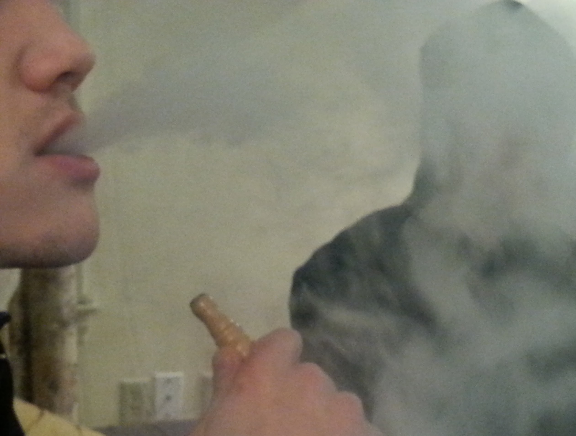I’m not a regular tobacco user, though I do enjoy smoking cigars or a hookah from time to time.
My personal policy is that most things in moderation are not harmful, but I really try to stay away from being a regular tobacco user because of its addictive qualities. My grandmother has been tobacco-free for at least two years now, but you can still smell the old smoke everywhere. I use her as an example of why I don’t want to be the raspy old man giving you a nicotine buzz during an elevator ride.
That, however, is my personal choice. St. Thomas will enact its new tobacco ban Jan. 1, 2014. After discussing the new policy in class and with friends, I’m convinced this is all a big waste of time.
Carefully examining the language of the new policy, you may notice there is something missing: a consequence for tobacco use. The new policy relies solely on community enforcement. This means that students and faculty are encouraged to tell their peers that on-campus tobacco use is banned.
Let’s get this straight. They want passive-aggressive Minnesotans to openly call strangers out for smoking? The problem here is I don’t think anybody is going to do that. Smokers may get a scowl from their peers, but nobody’s going to be confrontational when it’s minus 5 degrees, and we’re all just trying to make it to our 8 a.m. on time.
So what about Public Safety? I would think if the university is claiming to be tobacco-free, it would allow Public Safety to cite people for using tobacco on campus. But the new rule gives no citation authority to our campus authorities. With no citation privileges and plenty of better things to do, I think Public Safety will just look the other way. 
Finally, only two of the four St. Thomas campuses will be tobacco-free. The Rome campus and Gainey Retreat Center in Owatonna will not enforce the ban. I would assume Rome is not engaging in the ban because of the strong smoking culture in Italy. As for the Gainey Center, could this have anything to do with deterring customers from using our facilities? The companies and groups that visit Gainey may have tobacco users as employees, and a ban would alienate these clients.
With no means to make people stop using tobacco, it becomes less of a “ban” and more of a “suggestion.” But by calling it a ban, the university is setting itself up for failure. Just wait for the moment when Tommie Ambassadors tell their tour groups that our campus is “tobacco-free,” only to have someone light up right in front of them. It makes us as a university look inconsistent with our promises, and puts doubt into visitors’ minds.
I think the most laughable part of the policy is the inclusion of smokeless tobacco product. How is the university going to regulate a form of tobacco that is so inconspicuous, that the only evidence of use is a little bulge under your lip? The fact is, my high school couldn’t even regulate chewing tobacco, so for St. Thomas to try is disappointing because there are so many bigger problems it could focus on.
If the university really wants to make a dent in our community’s tobacco use, it needs to go with a more realistic approach. Saying the magic “tobacco-free” words isn’t going to make all the smokers and chewers on campus disappear or change their habits. This is especially true when the policy itself has no backbone.
The way I see it, St. Thomas has two stronger options moving forward. The first option is to revise the policy to penalize those who don’t follow it. With a no-tolerance option, you’d see tickets for tobacco use, forcing users to walk off campus. The next time you drive past St. Catherine’s, take a look at how this policy is working for them. Smokers line Randolph Avenue, pitching their cigarette butts onto the sidewalk with no receptacles in sight. Their university solved a smoking problem, but created a littering, campus involvement and image problem. I can already imagine the smokers lining up on Summit Avenue. Is that what we want to convey to people driving by St. Thomas?
This second option is the most realistic. Let’s abandon the notion that we can completely ban tobacco from this university. Instead, let’s take the funding for this policy and put it into a large-scale campaign for St. Thomas to help students quit. I would be so proud to say that my university has an aggressive program to help students quit that is heavily advertised on campus. While an initiative like this cannot make everyone quit, giving people resources to quit seems like a better idea than shutting the door on them and hoping they don’t come back.
In the end, people need to make the choice to quit on their own. We take pride in a clean campus where students can feel comfortable.
Alex Goering can be reached at goer8777@stthomas.edu.




Very well-written article, Alex, and all good points. I’m in agreement.
As a casual pipe smoker, I think it would be a good idea to have several designated smoking areas on campus instead of banning it campus-wide. The tables behind Morrison by the baseball field come to mind as a great spot for such a place.
Paul, tables just won’t do I’m afraid. They’d allow the smokers to sit down and be comfortable and that wouldn’t serve the conditioning programming well. Next thing you know, they’d want umbrellas to protect them from skin cancer or heaters to protect them from frostbite. Some of the radical smokers might even want an awning or roof to protect them from sleet or snow.
An exception COULD be made perhaps if the seats by the tables were programmed to deliver random electric shocks of varying, but never quite deadly, intensities. That would prevent undue interference with the social engineering aspects of the ban, although it would still force nonsmokers to view people smoking.
I would disagree with Alex that a total ban is difficult. Simply make it a one-strike-and-you’re-out offense for anyone caught with a tobacco product or who registers with a reasonable cotinine level in random blood checks at campus checkpoints: instant expulsions and firings without appeal. The policy would apply to all students, faculty, and workers.
See? It’s simple if you do it correctly.
Michael J. McFadden
Author of “TobakkoNacht — The Antismoking Endgame”
Commercially beneficial to whom?
Alex – The Wellness Center would love your help in expanding our program into a large-scale campaign! We currently are offering quits kits and free appointments in Health Service to assist student’s in quitting. Please contact us to set up a meeting – wellnessctr@stthomas.edu